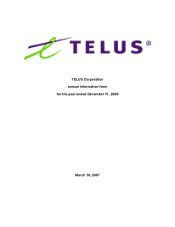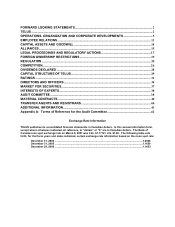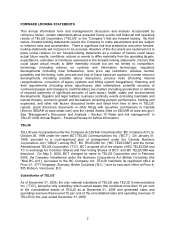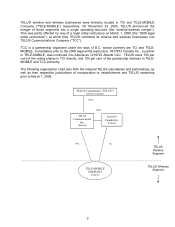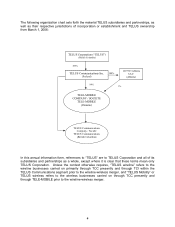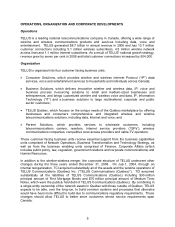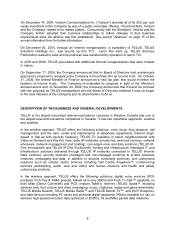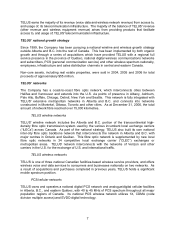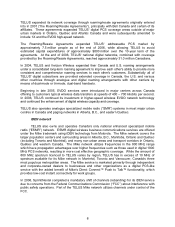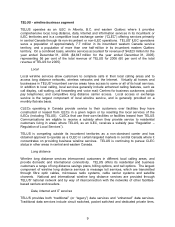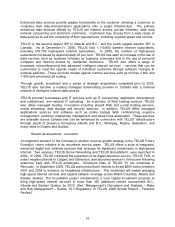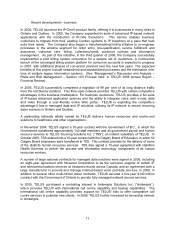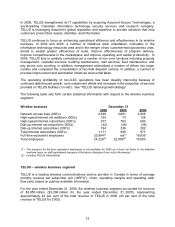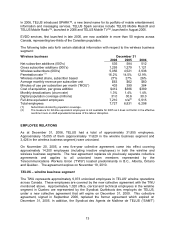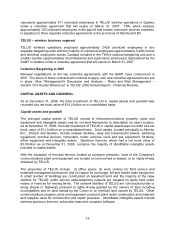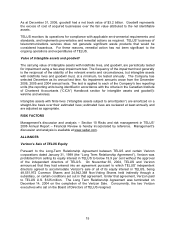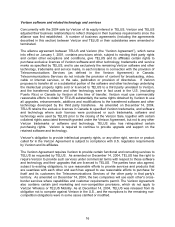Telus 2006 Annual Report Download - page 9
Download and view the complete annual report
Please find page 9 of the 2006 Telus annual report below. You can navigate through the pages in the report by either clicking on the pages listed below, or by using the keyword search tool below to find specific information within the annual report.TELUS expanded its network coverage through roaming/resale agreements originally entered
into in 2001 (“the Roaming/Resale Agreements”), principally with Bell Canada and certain of its
affiliates. These agreements expanded TELUS’ digital PCS coverage areas outside of major
urban markets in Ontario, Québec and Atlantic Canada and were subsequently amended to
include 1X and the EVDO high-speed network.
The Roaming/Resale Agreements expanded TELUS’ addressable PCS market by
approximately 7.5 million people as of the end of 2006, while allowing TELUS to avoid
estimated capital expenditures of approximately $800 million over the 10-year term of the
agreements. At the end of 2006, TELUS’ national digital networks, combined with coverage
provided by the Roaming/Resale Agreements, reached approximately 31.0 million Canadians.
In 2004, TELUS and Verizon Wireless expanded their Canada and U.S. roaming arrangements
under a consolidated long-term roaming agreement to improve each other’s ability to provide more
consistent and comprehensive roaming services to each other’s customers. Substantially all of
TELUS’ digital subscribers are provided extended coverage in Canada, the U.S. and various
other countries through analogue and digital roaming arrangements with other carriers by
means of dual-mode or tri-mode, dual-band handsets.
Beginning in late 2005, EVDO services were introduced in major centers across Canada
offering to customers typical wireless data transfers at speeds of 400 – 700 kilobits per second.
In 2006, TELUS continued its investment in higher-speed wireless EVDO network technology
and continued the enhancement of digital wireless capacity and coverage.
TELUS also operates analogue specialized mobile radio (“SMR”) systems in most major urban
centres in Canada and paging networks in Alberta, B.C., and eastern Québec.
iDEN network
TELUS also owns and operates Canada’s only national enhanced specialized mobile
radio (“ESMR”) network. ESMR digital wireless business communications services are offered
under the Mike trademark using iDEN technology from Motorola. The Mike network covers the
larger population centers and surrounding areas in Alberta, B.C., Manitoba, Ontario and Québec
(including Toronto and Montréal), and many non-urban areas and transport corridors in Ontario,
Québec and western Canada. The Mike network utilizes frequencies in the 800 MHz range
which have propagation advantages over higher frequencies such as those used in digital 1900
MHz PCS networks, resulting in more cost effective geographic coverage. While the amount of
800 MHz spectrum licenced to TELUS varies by region, TELUS has in excess of 10 MHz of
spectrum available for its Mike network in Montréal, Toronto and Vancouver, Canada’s three
most populous metropolitan areas. The Mike service is marketed primarily through independent
and corporate-owned dealers to businesses and other organizations as a digital PCS-like
service with the added benefit of Mike’s Direct Connect™ Push to Talk™ functionality, which
provides low-cost instant connectivity for work groups.
In 2006, Sprint/Nextel completed a mandatory shift of channels (rebanding) for its iDEN service
due to concerns from the Federal Communications Commission (“FCC”) about interference with
public safety operations. Part of the TELUS Mike network utilizes channels under control of the
FCC.
8

